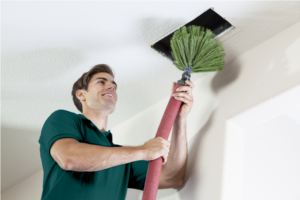Houston, TX, and the surrounding areas are known for having hot, humid summers. If you live near Houston, you understand the importance of an efficient, reliable HVAC system. One factor that may affect your AC efficiency is how the ductwork is laid out. Learn why ductwork layout matters, common design issues you may face, and more from the experts at Trilogy AC.

Why Ductwork Layout Matters for HVAC Efficiency
Your home’s air duct layout helps you get the best HVAC efficiency possible. Here’s why the HVAC duct design and layout in your home matters:
- Even air distribution: When your air ducts are laid out correctly, the cooled or warmed air is more evenly distributed throughout your home, keeping the temperatures balanced.
- Better airflow: An air duct design with minimal bends and transitions reduces friction and prevents airflow problems to provide more consistent airflow to every room of your home.
- Improved energy efficiency: Less resistance to the air coming from your HVAC prevents your system from working too hard, resulting in better energy efficiency and reduced heating and cooling costs.
- Healthier air quality: Ductwork that’s laid out efficiently and free of holes or cracks keeps the indoor air quality in your home safer and cleaner since it prevents potentially harmful airborne particles and contaminants.
Common Ductwork Design Issues That Reduce Efficiency
Here are some examples of common issues with ductwork, including improper duct placement, bad duct system designs, and more that reduce HVAC airflow and efficiency:
- Not enough return vents: If you don’t have enough return vents, the airflow balance is disrupted, which leads to uneven temperatures and reduced system efficiency.
- Inadequate insulation: Hot and cold air can escape without proper duct insulation, reducing system efficiency and increasing energy consumption.
- Improper layout: Long runs, sharp turns, and improper duct sizing all create excess friction that restricts airflow and efficiency.
- Leaks or cracks: If you have leaky ducts or cracks, the conditioned air escapes and causes your HVAC system to work harder, resulting in higher energy bills.
- Unsupported runs: Longer ductwork runs require proper support, but weak connections and improper support may cause the ducts to sag, significantly reducing system efficiency.
Best Practices for an Efficient Ductwork Layout
Fortunately, it’s possible to achieve a more efficient ductwork layout and better duct optimization. Remember these tips to make your home’s ductwork layout as efficient as possible.
Avoid Flex Ducts
Flex ducts are convenient and easy to install, but they’re more prone to leaks and less thermally efficient than metal ducts. If you currently have flex ducts in your home, consider upgrading to new, more energy-efficient ducts made of durable metal.
Use Filters in Return Grilles
Adding filters to return grilles keeps your return air ducts cleaner, improving airflow and indoor air quality. These filters also help to increase the surface area, keeping the HVAC air filter pressure drop lower and improving efficiency even further.
Aim for Straight Runs
While your air duct layout might not be completely straight throughout your home, the fewer bends and curves, the better. If you’re installing new ductwork or upgrading your current ductwork, verify that the new layout is as straight as possible to support maximum energy efficiency.
Keep Ducts Clean and Sealed
Clean, well-sealed air ducts free of leaks and cracks provide you with the best HVAC energy efficiency possible. Have your air ducts inspected and cleaned (if necessary) at least once a year as part of a good preventative maintenance plan. Your ductwork should also be properly insulated.
Use the Right Air Duct Size
Size matters when it comes to best practices for air ducts. If the ductwork is too small, it may be too loud, create imbalanced airflow, and cause excess static pressure. If it’s too large, it can eventually sag or even come apart at the seams, significantly impacting your HVAC system’s efficiency.

Should You Upgrade or Redesign Your Ductwork?
Look for these signs indicating it’s time for repairs, a complete air duct replacement, or a ductwork redesign:
- Old ductwork: The average lifespan of ductwork is between 20 and 25 years, so if yours is around 15 to 20 years old or older, you may want to consider an upgrade.
- Damage: If your ductwork has cracks or leaks, contact Trilogy AC to determine whether it’s best to seal and repair it or replace it.
- Poor system performance: If your HVAC system isn’t performing optimally and you notice high energy bills or poor indoor air quality, it may be due to a ductwork issue.
- More contaminants: An increase in airborne particles like dust, mold, and pet dander inside your home might mean that your ductwork is damaged and needs attention.
- Hot and cold areas: If you notice certain areas of your home are too hot or too cold, it could be due to an improper ductwork layout or other ductwork issues.
- High utility bills: Skyrocketing utility bills might indicate leaking or poorly laid-out ductwork.
- Strange noises: If your ductwork makes unusual rattling or banging sounds, it should be inspected and repaired or replaced as soon as possible.

Contact Trilogy AC Today
Don’t let a poor ductwork layout, dirty ducts, or leaking ductwork affect your comfort. Count on the experts at Trilogy AC Cooling and Heating to address all your HVAC and ductwork needs. We proudly serve customers in Katy, Cypress, Jersey Village, Houston, TX, and the surrounding areas. If you’d like to learn more about us or want to find out how we can help improve your HVAC system’s efficiency, contact us today to schedule service.








